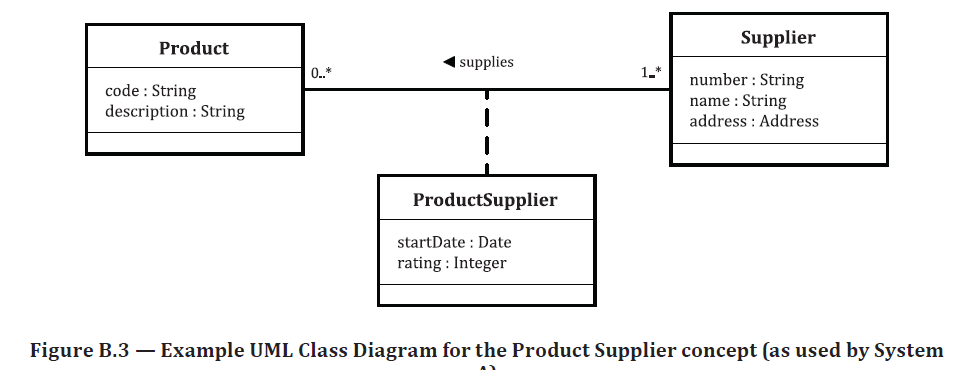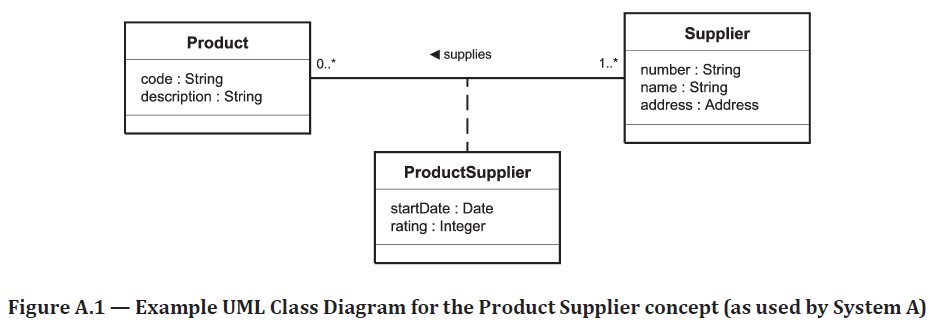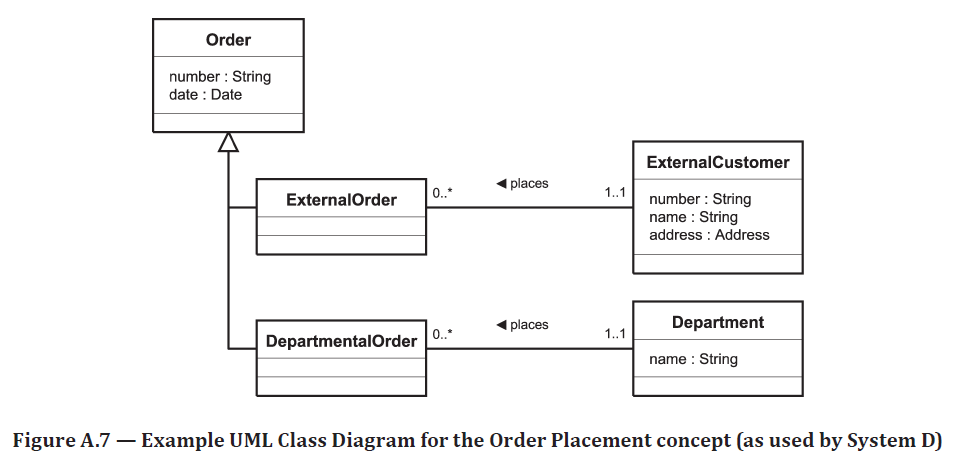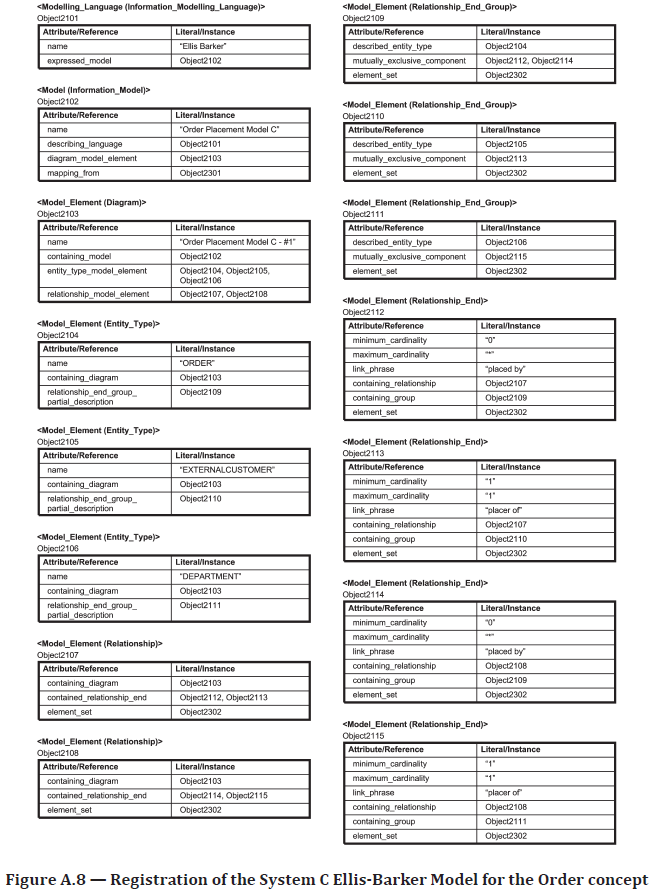Views: 19
ISO 11179:2023 Semantic model definition using ISO/IEC 19505 OMG UML
Nobuyuki SAMBUICHI
ISO/TC295 Audit data services/SG1 Semantic model Convener
In the 2023 version of ISO/IEC 11179, we can define the UML semantic model and hierarchical logical data model with the ISO/IEC 11179-3 terms without using ISO 15000-5 CCS.
The electronic version of ISO/IEC 11179-1:2023 and ISO/IEC 11179-3:2023 can be downloaded from the
ISO/IEC Information Technology Task Force (ITTF) web site.
1. Example in ISO/IEC 11179-3
ISO/IEC 11179-3 Annex B.4 shows two different models with different notations and a mapping definition between two semantically equivalent models. The association between the Product class and the Supplier class is the ProductSupplier class that defines the association between a Product and a Supplier.
This notation is close to the one we used in ISO 21378:2019 Field table and PK/REF table.
Annex B
(informative)
Illustrations of Item_Mapping
B.4 Example of ‘Semantically_equivalent’ mapping degree
B.4.1 Overview of example
This example shows the use of Item Mapping to record that two models using different notations are semantically equivalent. The example illustrates the mapping between an information model expressed as a UML Class Diagram used by System A (see Figure B.3), and an equivalent information model expressed using the IDEF1X notation and used by System B (see Figure B.4).
This model is explained in ISO/IEC 19763-10 Information technology — Metamodel framework for interoperability (MFI) — Part 10: Core model and basic mapping Annex A (informative) Examples.
ISO/IEC 19763-10 Figure A.3 — Registration of the System A UML Class Diagram for the Product Supplier concept describes UML diaglam in tabulae definition. This document can be downloaded from the
ISO/IEC Information Technology Task Force (ITTF) web site.
Figure A.3 shows a set of tables defines and/or reference Object definition tables corresponding to the UML class diagram. It seems complicated and I converted these to the different representatiuon using the form used in clause 6.
1.1. UML Class Diagram in Figure A.1
6 Detail provided in each metaclass definition
Its direct superclass is specified under the heading of
Superclass`.Its attributes are listed and defined under the headings
Attribute,DataType,Multiplicity, and
Description, under each of which, the name of the attribute, its datatype, its multiplicity, and a
description are given, respectively.Its references are listed and defined under the headings
Reference,Class,Multiplicity,Description,
Inverse, andPrecedence, under each of which, the name of the reference, the name of the associated
metaclass, its multiplicity, a description, its inverse reference name, and whether it has precedence over
its inverse reference or not, are given, respectively. The inverse reference name shall be the name of the
reference in the associated metaclass which is complementary to this reference.If a class has any other constraints, they are described in a natural language under the heading of
Constraints.In UML, an
associationis equivalent to areference and its inverse reference. In this part of ISO/IEC 19763,
to formally define a metaclass, associations are not used, but eachassociationis replaced bytwo, a
referencesreferenceand itsinverse reference. If a reference has precedence over its inverse reference,
it means that instances of the relevant metaclass have responsibility for maintenance of the links of the
association defined by it and its inverse reference.
1.1.1. Product
Superclass
None
Attribute
| Attribute | DataType | Multiplicity | Description |
|---|---|---|---|
|
code |
String |
1 |
|
|
description |
String |
1 |
Reference
| Reference | Class | Multiplicity | Description | Inverse | Precedence |
|---|---|---|---|---|---|
|
None |
|||||
1.1.2. Supplier
Superclass
None
Attribute
| Attribute | DataType | Multiplicity | Description |
|---|---|---|---|
|
number |
String |
1 |
|
|
name |
String |
1 |
|
|
address |
Address |
1 |
Reference
| Reference | Class | Multiplicity | Description | Inverse | Precedence |
|---|---|---|---|---|---|
|
None |
|||||
1.1.3. ProductSupplier
Superclass
None
Attribute
| Attribute | DataType | Multiplicity | Description |
|---|---|---|---|
|
startDate |
Date |
1 |
|
|
rating |
integer |
1 |
Reference
| Reference | Class | Multiplicity | Description | Inverse | Precedence |
|---|---|---|---|---|---|
|
supplies |
Product |
0..* |
– |
code |
– |
|
suppliedBy |
Supplier |
1..* |
– |
number |
– |
1.2. UML Class Diagram in Figure A.7
In order to better understand and study the relations depicted in Figure A.8, I have created a separate relation diagram that provides a clearer representation of the connections between the tables. This diagram serves as a visual aid to help visualize the relationships and facilitate a more comprehensive analysis of the interconnected tables.
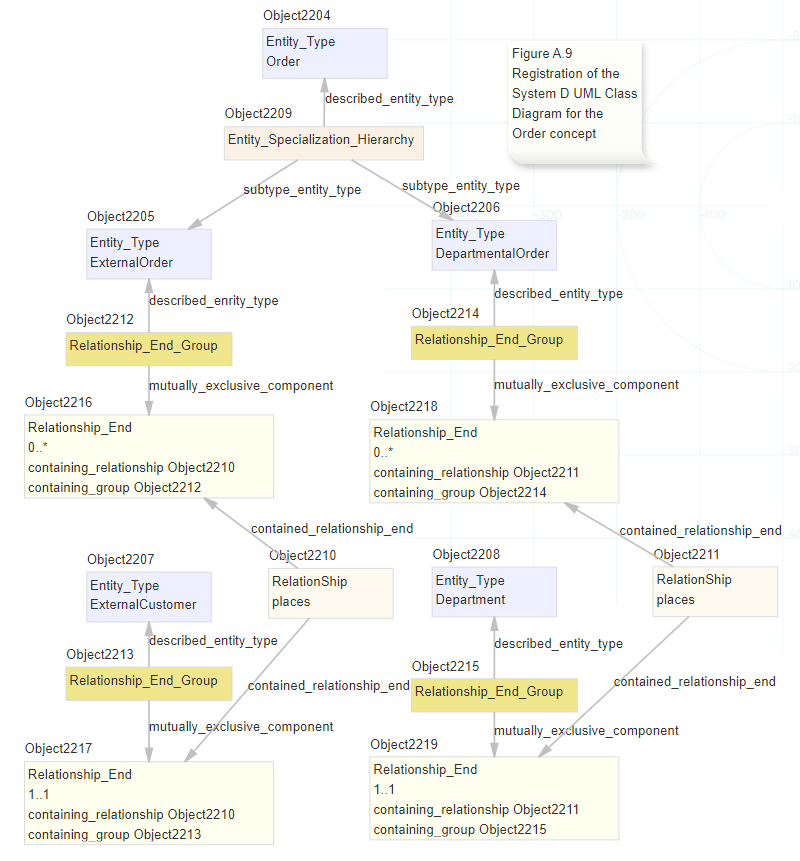
1.2.1. Order
Superclass
None
Attribute
| Attribute | DataType | Multiplicity | Description |
|---|---|---|---|
|
number |
String |
1 |
|
|
date |
Date |
1 |
Reference
| Reference | Class | Multiplicity | Description | Inverse | Precedence |
|---|
1.2.2. ExternalOrder
Superclass
Order
Attribute
| Attribute | DataType | Multiplicity | Description |
|---|---|---|---|
|
None |
|||
Reference
| Reference | Class | Multiplicity | Description | Inverse | Precedence |
|---|---|---|---|---|---|
|
placedBy |
ExternalCustomer |
1..1 |
– |
number |
– |
1.2.3. ExternalCustomer
Superclass
None
Attribute
| Attribute | DataType | Multiplicity | Description |
|---|---|---|---|
|
number |
String |
1 |
– |
|
name |
String |
1 |
– |
|
address |
Address |
1 |
– |
Reference
| Reference | Class | Multiplicity | Description | Inverse | Precedence |
|---|---|---|---|---|---|
|
places |
ExternalOrder |
0..* |
– |
placedBy |
– |
1.2.4. DepartmentalOrder
Superclass
Order
Attribute
| Attribute | DataType | Multiplicity | Description |
|---|---|---|---|
|
None |
|||
Reference
| Reference | Class | Multiplicity | Description | Inverse | Precedence |
|---|---|---|---|---|---|
|
placedBy |
Department |
1..1 |
– |
name |
– |
1.2.5. Department
Superclass
None
Attribute
| Attribute | DataType | Multiplicity | Description |
|---|---|---|---|
|
name |
String |
1 |
– |
Reference
| Reference | Class | Multiplicity | Description | Inverse | Precedence |
|---|---|---|---|---|---|
|
places |
DepartmentalOrder |
0..* |
– |
placedBy |
– |

